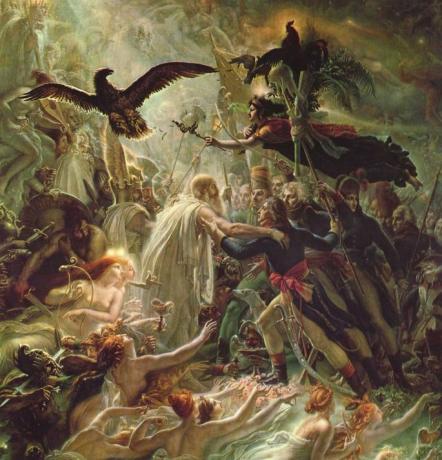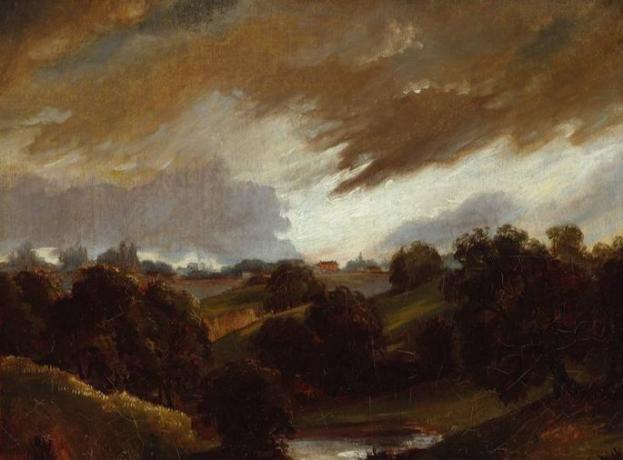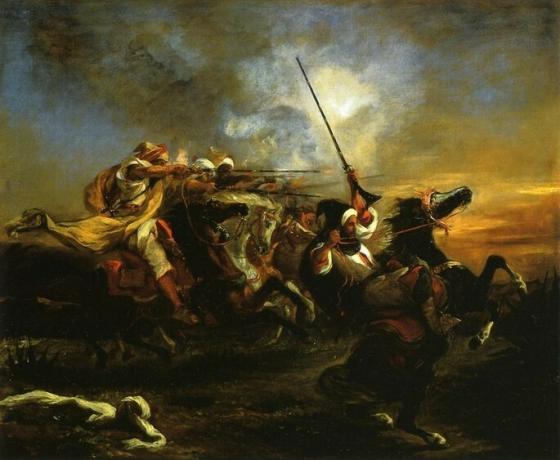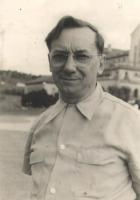Characteristics of romanticism, concept and values
The transition from the 18th to the 19th century was marked by the emergence of Romanticism, a movement artistic and literary that made creative freedom and the expression of subjectivity the center of his proclamation.
Romanticism was opposed to the aesthetics of neoclassicism, governed by reason and morality. Both were contemporary movements, although neoclassicism was the first to appear. The Romantic movement prompted the flowering of creativity and artistic originality.

Each artistic discipline in the Romantic movement had different challenges and scope. Painting, for example, implied an authentic transformation in the concept and role of the plastic arts in society, that until then occupied a very important place in the service of the propaganda of the State and the Church, their main patron.
The romantic revolution created new conditions for artistic production by relating art to the exercise of consciousness and individual creativity. Historian Ernest Gombrich states that:
The idea that the true purpose of art was to express personality could only gain ground when art had lost its other purposes.
By understanding the arts as a vehicle for individual expression and, consequently, as a vocation, many artists and Romantic writers resigned from the commission and were compelled to sell their works so as not to "sell" themselves as artists. Thus, along with the cult of the artist consecrated as a provider of spiritual content, the number of proscribed and economically bankrupt artists, because for the new public it was safer to bet on art traditional.
To better understand this new concept of art and the consequences derived from it, in this article we are going to know the main characteristics of romantic painting based on three aspects:
- The core values of the romantic program (purpose and values);
- The formal characteristics applicable to the different disciplines (style);
- The themes of representation.
Values and programmatic aspects of the romantic movement

Imagination vs. intelligence
Romantic painters exalted the imagination in two ways: as a creative element and as a form of knowledge. It is a reaction to neoclassical art, which rejected the symbolic value of the imagination as contrary to the spirit of reason and morality.
Sublimity vs. classic beauty
Romantic artists react against the classical canon of beauty (order, proportion, and symmetry), which had become predictable and stereotyped, and they do so through the notion of what sublime.
Unlike the classical canon that produces pleasure and harmony, the sublime is a displeasure, that is, a shudder or transcendent restlessness that results from the mismatch between the imaginative grandeur of what is contemplated and what is expected by the reason. The sublime moves, shakes, and disturbs the viewer in a captivating way; It takes him out of his comfort zone and forces him to recognize other forms of beauty other than order, proportion and symmetry.
Subjectivity vs. objectivity
In romanticism it is proposed that art obeys only the purpose of expressing the artist's subjectivity, that is, his point of view, sensitivity, opinions, concerns and desires. In this sense, it frees art from subordination to the interests of the client and, particularly painting, frees it from commission. Thus arises the concept of art as individual expression.
Nationalism vs. universality
Nationalism and patriotism are two values that romantic art and neoclassical art shared, but they did so from two totally different points of view. In fact, historian Eric Hobsbawm points out that romanticism and neoclassicism were but two sides of the same coin.
Let us note what the differences would be in this aspect of nationalism. While in neoclassical art he defended the concept of the national state as a rational order and a means for civilizational development, romanticism values the concept of national identity. To that extent, the State brings together the children of the nation, of the community of brothers.
Formal and stylistic aspects of romanticism

Diversity of styles
If something characterized romantic art, it was the diversity of styles that necessarily imposed itself by freeing itself from academic rules and by seeking subjective expression. Neither the arts nor the literature of Romanticism can be considered as a unified style in any way.
In fact, romanticism cannot be considered either as a period but as a movement that bordered on others (neoclassicism, realism, symbolism, pre-Raphaeliteism). What can be said is that romanticism exerted a truly significant influence in the art of the nineteenth century and that foreshadowed the foundations of the concept of literature and art modern.
Rules release
Romantic artists and writers break free from the rigidity of academic rules, although this does not mean that they have completely renounced them. In some cases, it seems that the rules disappear completely; in others, they are seen as subordinate to the expression of individual subjectivity and, therefore, used at the whim of expressive necessity. In any of the scenarios, the artist has deliberately freed himself from academic rigor in search of his own style that identifies him.
Romantic irony
Irony was one of the most explored elements in romanticism, especially literary romanticism. It is a kind of attitude of mind towards the modes of representation of reality, which questions the limits of the understanding of reason. The irony thus allows to open infinite possibilities in the artistic work.
Avoidance of clarity and definition

The artists of romanticism are interested in emotional states, especially those that reveal a certain embarrassment. If the painting is a metaphor for the inner world, knowingly so confused, the painter is interested in the transmission of the psychological atmosphere, and for this he uses the lack of clarity and definition. The same is true in literature and in the music of the Romantic movement.
Influence of baroque art, especially in French romanticism

In the case of France, Romanticism returned, once again, to the masters of the Baroque period, whom the Enlightenment had condemned as confusing, extravagant, and ornate. The baroque was reread from the romantic key, although directed to the new topics of modern interest. The large motley scenes reappeared, looking chaotic and exuberant.
Expressive purposes dominate the finishes or formal precision

While neoclassicism made a real effort to hide the procedures that made the viewer forget about the artist as an intermediary between himself and the idea, romanticism recalls his presence, leaving the procedure in view, that is, deliberately allowing for imperfection, asymmetry, inaccuracy, or unfinished form, whether in painting, music, or literature.
Dynamism

Compositions in romanticism renounce the uniqueness of neoclassical compositions and opt for dynamic and tension-laden compositions.
Romantic themes
Pictorial romanticism shared the same universe of subject interests as literature and music. Among the most recurrent themes can be recognized:
Moods and feelings
The most common representational themes in romantic painting derived from the expression of the subjective world of the artists. Topics such as feelings of loneliness, anguish, nostalgia, abandonment, love, madness, passion, fear or terror were more than frequent and, in fact, it can be said that these issues were transversal in all the topics developed in the romanticism.
Death
Death was, of course, a great concern in romantic artists, and it was approached from many points of view. There was also particular interest in the subject of suicide during Romanticism, in turn encouraged by the influence of the novel Young Werther's Misadventuresby Goethe.
The history

Romantic artists committed to libertarian and nationalist political values frequently represented the themes of history that endorsed such values. This element had particular adherence to American romanticism, completely oblivious to the interest in the Greco-Latin past.
Both in Europe and America, romantic art depicted historical passages from the Middle Ages and other periods such as contemporary times, which in some way constitute a vindication of the cause of the nation and the Liberty. The French Revolution was, in this sense, one of the favorite subjects in the context of French art.
History in romanticism also includes the hero, but unlike neoclassical art which shows him as a temperate and self-controlled being, full of moral virtues, romanticism prefers it excessive, passionate and tragic.
Landscape

Romanticism returns to the landscape in two ways: the first, as an effort to bridge the distance between man and nature derived from socio-economic changes; the second, as a metaphor for the inner world of the subject. Once again, he is an affront against neoclassical rationalism that, in most of his compositions, preferred the interior and sober scenes to focus the viewer's attention on the message.
The mythical and legendary literary universe

The romantics go in search of new content in the literature of all times, leaving aside the Greco-Latin references. They go especially to that literature that provides fantastic elements, wonderful creatures, beasts, alternative mythologies, etc.
Popular culture

There was also a growing interest in the representation of popular culture, which was considered the depository of national identity. Not necessarily the vision of popular culture would be bucolic. It could also be linked to the magical-religious universe and to a certain legitimation of the "chaos" that so disturbed the enlightened.
Nostalgia for faith and spirituality

Neoclassicals and romantics alike believed that all past times were better, but both in a different way. The neoclassicists opposed the role of tradition, which they blamed for fanaticism, and for this reason they believed they saw a rationalist model in the Greco-Latin past.
Meanwhile, the romantics hated the excess of Enlightenment rationalism, and yearned for the medieval past and "primitive" times. They lamented the disappearance of spirituality and the sense of magic in life. At the same time, they valued the popular past as the primeval source of national being. This nostalgic gaze was also like the acceptance of a small death that pictorial romanticism regrets over and over again in its paintings.
The American Aboriginal
Another of the great themes within the line of the past as nostalgia, is the American aboriginal world, which they interpreted as a symbol of the unity between human beings and nature. Of course, it was an idealization inspired by Jean-Jacques Rousseau's concept of the good savage.
Exotic affairs

It is with the romantics that interest in the so-called "exotic cultures" charged with a unique sense of color and composition begins to spread. One of the most widespread currents is orientalism, which is reflected not only in the study of aesthetic criteria but also in the subjects represented.



